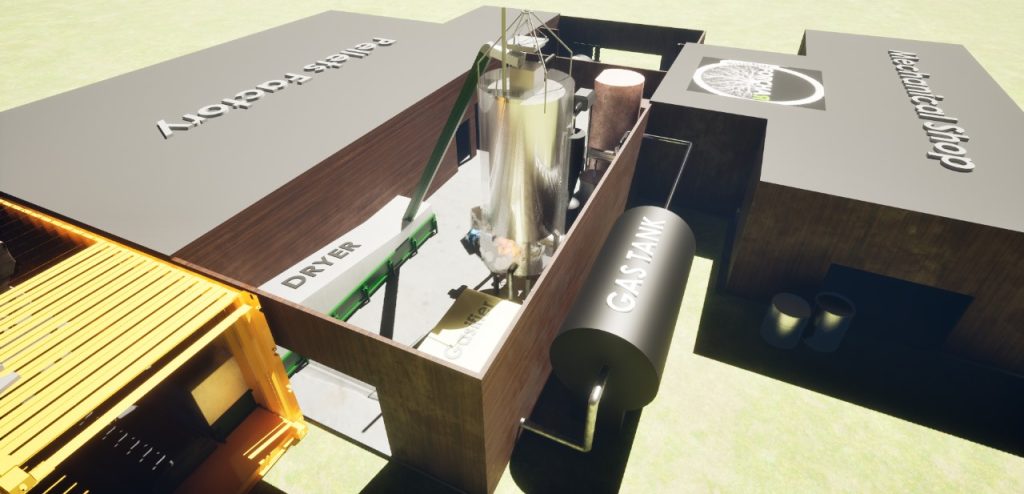Pyrolysis System

Understanding the Process
Biochar Production Method
Our Pyrolizer technology is at the forefront of sustainable biochar production. This advanced, thermalized treatment furnace reaches temperatures up to 1000 degrees Celsius, enabling efficient thermal combustion in an oxygen-free environment. This method ensures the organic material undergoes complete carbonization without oxidation, producing high-quality biochar. The Pyrolizer’s design not only maximizes yield but also minimizes emissions, making it a clean, eco-friendly choice for biochar production.
Historical Perspective and Modern Practices
Biochar and Traditional coal Production
FORCHAR is set to launch biochar as a sustainable, high-impact product for the Food and Energy markets. Positioned as an alternative clean energy source, biochar supports the circular economy and aligns with the goals of the New Green Economy. Strategically focused on agriculture, FORCHAR aims to transform intensive farming into regenerative agriculture by demonstrating biochar’s benefits for crop yield and farmer profitability. Additionally, biochar’s high calorific value and energy properties make it ideal for industries requiring substantial thermal power, such as cement and metallurgical companies, especially as a competitor to mineral coal. Laboratory tests with certain cement plant in 2023 highlighted that FORCHAR’s biochar surpasses mineral coal by 1 to 5 gigajoules in thermal energy. As government regulations tighten, including carbon credit incentives, biochar emerges as a compelling, eco-friendly solution amid the decline of mineral coal, supporting global climate initiatives.


Biochar: The Modern Solution
Our program is dedicated to continuously pursuing a wide range of technological innovations. We are particularly focused on advancing methods for greenhouse gas (GHG) sequestration, developing new thermal processing technologies, and exploring innovative ways to chemically transform gases. Core to our efforts are the Pyrolizer and Biochar, which form the backbone of our technology solutions and play a crucial role in achieving our sustainability objectives.
To remain at the cutting edge of these fields, we have established a robust, ongoing research initiative. This includes intensive collaboration with researchers and experts from various disciplines, all working together to push the boundaries of what’s possible. Our aim is not only to lead in technological advancements but also to drive impactful solutions that address environmental and industrial challenges. Through this continuous research and development, we strive to maintain our leadership position and ensure that our technologies make a meaningful contribution to a more sustainable and resilient future.
Technological Innovations
Advancing Sustainable Agriculture with Pyrolysis Technology
Our flagship piece of equipment, now and for the foreseeable future, is the Pyrolizer, which transforms biomass into biochar. For the past two years, we’ve been developing plans to launch a third-generation Pyrolizer by the end of 2023. Our dedicated engineering, design, and R&D teams are fully engaged in designing this cutting-edge technology, with plans and prototypes currently under review. The next steps: a funding campaign, followed by engineering and manufacturing.
With this new generation, we’re aiming higher. Our goal is to produce biochar at a price competitive with coal, lime, or perlite. Achieving such low production costs will require a revolutionary new piece of equipment—unlike anything currently in use in Quebec—which will rapidly dry and process biomass, aligning perfectly with our cost-efficiency targets. In the coming years, the number of Pyrolizers in operation is expected to grow, but what will set the high-performance units apart will be their hourly production capacity and cost-effectiveness.


Unearthing Centuries-old Soil Secrets
Discovery of Terra Preta
The rediscovery of this lost civilization is fascinating. Perhaps more surprising is the discovery of ‘Biochar’, which made the soil of the terra preta region. Even chemical fertilizers cannot maintain crop yields into a third consecutive growing season, yet these dark earth have retained their fertility for centuries. A crop planted on terra preta can yield up to four times greater than one produced on soil from a similar parent material. The facts of terra preta soil were reported and brought to light by Dutch soil scientist Wim Sombroek in 1966



